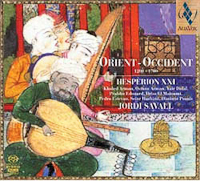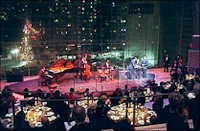| E-mail me at mcclainm@optonline.net | Visit my Facebook page | View my LinkedIn profile |

The musical performance at 8:00 p.m. was preceded by a panel discussion moderated by Ara Guzelimian, with Karen Armstrong, Manuel Forcano, Osvaldo Golijov, and Jordi Savall.
Ara Guzelimian is the Dean of the Julliard School.
Karen Armstrong is an author of numerous books on comparative religion.
Manuel Forcano is a poet and translator of ancient texts from the Hebrew, Aramaic and Arabic.
Osvaldo Golijov is a composer who writes pieces for the Kronos Quartet, Yo-Yo Ma and the like.
Jordi Savall is a leading performer of early music and the developer of the Jerusalem project.
No lightweights on this card.
The Irene Diamond Educational Center was packed; we were lucky to find seats. The discussion centered on the power of music to moderate the conflicts among Jewish, Muslim, and Christian cultures, especially in the ancient city of Jerusalem. All agreed that the history of relations among the cultures, especially since the Christian crusades in the 11th and 12th centuries and the expulsion of Muslims and Jews from Spain in 1492, has been conflictual, and that relations have grown more strained since the terrorist attack of 9/11.
The panel - and most of the audience - seemed heartened, however, by Jordi Savall's vision of music - and especially early music - as the language of peace. Simple melodies, played on simple instruments, he said, speak to the heart. With music, we cannot lie.
Most of the questions were polite, generally hovering around the question of how to spread this message of hope across cultures, classes and generations. One man at the rear startled the crowd by asking whether a terrorist would stop to listen to music before launching an attack. A gasp escaped the audience. Jordi Savall raised an eyebrow, as if hearing the voice of an old friend from across the room. He responded calmly to what he termed a 'demagogic question'. If all people were free, if everyone received a good education, if justice prevailed across the globe, he said, we would not have to worry about terrorists.
During the question and answer session, Osvaldo Golijov let it be known that his 'good friend' Yo-Yo Ma was in attendance. Heads craned. As the discussion broke up and we moved to the Allen Room for the performance, we spotted Mr. Ma emerging from the men's room, and taking his place on line with us to be admitted to the concert hall.
 |
The ensemble, Hesperion XXI, consisted of seven musicians from seven countries playing traditional instruments - and playing them exceedingly well.
As we entered the concert hall, Yo-Yo Ma was questioning Jordi Savall about his rebab, an ancient string instrument played between the legs using a bow. Dimitri Psonis was tuning the seventy-two strings of his santur while Haig Sarikouyoumdjian warmed up his duduk. Once the members of the ensemble were satisfied with their tuning and the audience was firmly seated, the concert began with a plaintive Arabic melody - one of those simple songs on a simple instrument Jordi Savall mentioned earlier. Songs from Armenia, the French middle ages, Sephardic Alexandria, and other equally exotic places and times followed, one more soulful than the next. The sight of fire engines and police cars gathering outside on 59th Street didn't seem to matter.
A solo by percussionist David Mayoral drew spontaneous and enthusiastic applause. Throughout the evening, Mr. Mayoral's performances on drums, tambors, and tambourines were awe inspiring. With a few strokes of his fingers he evoked thunderstorms, heartbeats, and other rhythms of nature. Pierre Hamon showed off a double flute and Gaguik Mouradan enchanted the audience with a solo on the kamancha.
As we rode the elevator from the sixth floor to the lobby, we heard a woman's voice from the back of the car asking her companion, "You didn't really like that music did you?" A man, presumably her husband, replied that some of it was "alright". "But it was so primitive," she said. The couple next to us exchanged knowing smiles as we dispersed into the night, inspired by the music of peace, but knowing that not everyone can yet hear it.
Here is a link to the review of the performance in the New York Times.